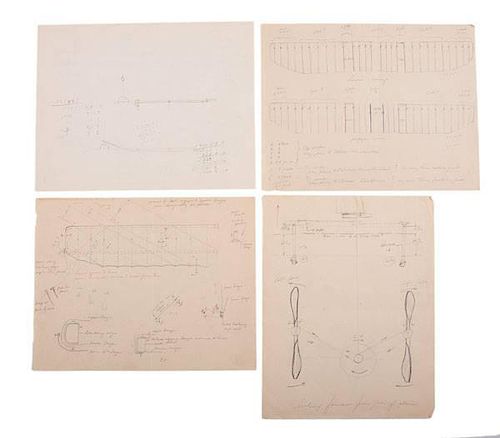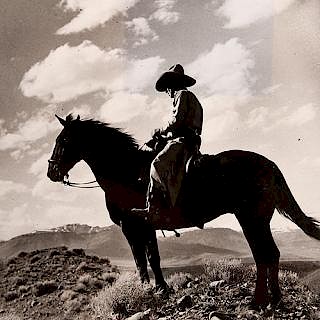Wright Brothers, Louis P. Christman's Working Notebook, Including Diagrams, Stock Requisitions, Sketches, and Other Correspondence on Reconstruction o
About Seller
6270 Este Ave.
Cincinnati , OH 45232
United States
With offices in Cincinnati, Cleveland and Denver, Cowan’s holds over 40 auctions each year, with annual sales exceeding $16M. We reach buyers around the globe, and take pride in our reputation for integrity, customer service and great results. A full-service house, Cowan’s Auctions specializes in Am...Read more
Two ways to bid:
- Leave a max absentee bid and the platform will bid on your behalf up to your maximum bid during the live auction.
- Bid live during the auction and your bids will be submitted real-time to the auctioneer.
Bid Increments
| Price | Bid Increment |
|---|---|
| $0 | $25 |
| $500 | $50 |
| $1,000 | $100 |
| $2,000 | $250 |
| $5,000 | $500 |
| $10,000 | $1,000 |
| $20,000 | $2,500 |
| $50,000 | $5,000 |
| $100,000 | $10,000 |
About Auction
Jun 12, 2015 - Jun 13, 2015
Cowan's Auctions dawnie@cowans.com
- Lot Description
Lot of over 250 notes and related receipts, documents, manuscripts, and photocopied materials compiled and/or accumulated by Louis P. Christman while working on the reconstruction of the 1905 Wright Flyer, most dated ca 1948-1949. Many of the original documents are signed by Christman or other individuals involved in the reconstruction project.
br> Among the many documents, Christman's "working notebook" contains the following highlights: approx. 30 stock requisitions, with at least 18 related to materials obtained for the reconstruction of the 1905 Wright Flyer; over 30pp of penciled notes and calculations done by Christman while working at the Smithsonian; approx. 10pp of typed and written engines notes mainly regarding the 1903 Wright Flyer; 30+ request for "Inter-Departmental Work" for the "Carillon Park Aeroplane Project," signed by Christman and his supervisor Henry Geyer; 30+ written and typed letters, some carbons, consisting of correspondence between Christman and the Diamond Chain Company, which produced the propeller chain for the Wright Brother's first aircraft and was involved in making tools/parts used in the reconstruction of the 1905 flyer. Some of the letters are signed by the company's president, Guy A. Wainwright.
The collection also features over 50 large format copies owned by Christman, many of which are reproductions of pages and diagrams related to early aviation, published in German by "Der Motorwagen", as well as at least 10 Dayton area newspapers, 1948-1961, referencing the Wright Brothers, including the death of Orville Wright. A large, original map of Cape Hatteras National Seashore and a copy of a boundary map of Kill Devil Hill National Monument, Kitty Hawk, NC, also accompany the lot.
Louis P. Christman (1893-1972)
As an employee of National Cash Register, with his experience in aircraft and machine design, Louis P. Christman was called upon by prominent engineer and inventor, Colonel Edward Deeds, to undertake the restoration of the 1905 Wright Flyer, which resides at Carillon Park, Dayton, Ohio. Christman was given the opportunity to work closely with Orville Wright in order to produce an accurate set of drawings, or blueprints, for the 1900, 1901, and 1902 gliders as well as the 1903, 1904, and 1905 Wright Flyers. Since no complete drawings were ever produced by Orville and Wilbur Wright during the building and flying of the planes, it was required that Christman travel to Washington, D.C. to the Smithsonian Institution to take measurements and make drawings from the original 1903 Flyer that is displayed there and to discuss these drawings with Orville Wright.
Continued meetings and conversations between Orville Wright and Christman resulted in a very refined set of drawings of the three planes and their engines – drawings that were quite satisfactory to Orville Wright. Christman, under the direction of Colonel Edward Deeds, then began the restoration of the 1905 Flyer in 1947, on the grounds of the National Cash Register Co. This project involved not only incorporating as many original parts as could be obtained, but the designing and machining of matching parts in order to complete the aeroplane. This restoration project took Christman approximately 19 months, from the drawing stage to the completion of the frame. Final construction and assembly was completed at Carillon Historical Park, where the plane was reassembled and fabric was stretched.
Christman’s drawings are well documented in the Smithsonian Institution’s National Air and Space Museum. Knowledgeable men and women who have produced models and full-sized planes since 1948 have relied most exclusively on the “Christman Drawings.” The Smithsonian Institution has recently produced framed copies of Christman’s three view plate, with consideration in print concerning the works of Christman. The work that Christman did for Orville Wright, Dayton Wright Aeroplane, Charles F. Kettering, Inland Manufacturing, NCR Corp., Colonel Deeds, and Carillon Park is of considerable historical importance and interest.
Lots 284-290 represent a portion of items given to Christman for his work in restoring the 1905 Wright Flyer, and they have descended directly in his family.Condition varies, but most of the original notes, receipts, diagrams, letters, etc. remain in very good condition overall, and show very little wear. The large copies show a bit more wear, including some light soiling. Boundary map of Kill Devil Hill has suffered some loss in top left corner, as well as wear along left edge.Condition
- Shipping Info
-
SHIPPING. At the request of the buyer, Cowan's will authorize the shipment of purchased items. Shipments usually occur within two weeks after payment has been received. Shipment is generally made via UPS Ground service. Unless buyer gives special instructions, the shipping method shall be at the sole discretion of Cowan's Auctions, Inc.. Cowan's is in no way responsible for the acts or omissions of independent handlers, packers or shippers of purchased items or for any loss, damage or delay from the packing or shipping of any property.
-
- Buyer's Premium



 EUR
EUR CAD
CAD AUD
AUD GBP
GBP MXN
MXN HKD
HKD CNY
CNY MYR
MYR SEK
SEK SGD
SGD CHF
CHF THB
THB


















